Term archive
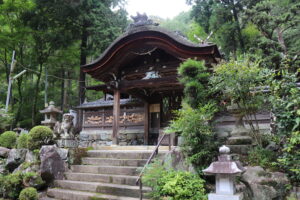
投稿タイプ:sightseeing
Tamatsuoka-jinja Shrine
This shrine is said to have originated in 540 when the female deity Shitateruhime no Mikoto descended to this place and was enshrined. In 731, Tachibana no Moroe established it as the local shrine. In the precincts, there is a smaller shrine dedicated to him, Tachibana-jinja Shrine. In addition, many other deities are enshrined here. The current main hall was constructed in 1687. It is built in a traditional Shinto shrine architectural style called Kasuga-zukuri.
Enveloped in dense foliage, the shrine is filled with cool air and deep shade of trees even in the midst of summer.
Right nearby, there is Jizozen-in Temple, where you can find a weeping cherry tree that is approximately 300 years old. The tree is designated a Natural Monument of Kyoto Prefecture.
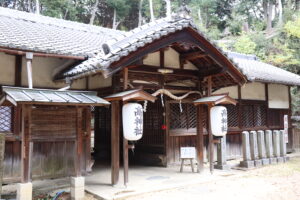
投稿タイプ:sightseeing
Taka-jinja Shrine
Taka-jinja Shrine, founded in 711, has long been a place of worship among the local people. With the Chinju no Mori (the sacred shrine grove), one of the 100 landscapes of Kyoto, the shrine is enveloped in a tranquil atmosphere. The main hall, built in 1604, is a cultural property designated by Kyoto Prefecture. This building preserves the gorgeous decorations that are one of the characteristics of its time.
A document of the shrine from the Kamakura Period (1185-1333) records that a traditional Japanese theatre, sarugaku (a precursor to nōgaku performing arts) was performed when the shrine was reconstructed. This is one of the earliest records of sarugaku in Japan, further enhancing the shrine's historical significance.
Also, the nearby area is beloved for its hiking trails, as well as cherry blossoms in spring and fireflies in early summer.
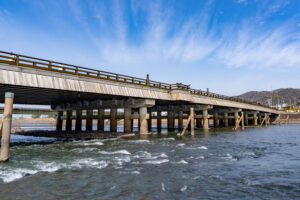
投稿タイプ:sightseeing
Uji-bashi Bridge
In Hashidera Hojoin temple, there remains one of Japan’s oldest fragments of stone monuments. It states that Doto, a monk from Gango-ji temple in Nara, built the Uji-bashi Bridge in 646.
The bridge is considered one of three major ancient bridges of Japan, along with Seta no Karahashi Bridge, and Yamazaki-bashi Bridge (now lost). The bridge is also a part of the Japan Heritage.
The current bridge was constructed in March 1996. Its balustrades have giboshi (ornamental finials). The elegant design retains its historical image of the bridge, and is in harmony with the surrounding scenery.
The bridge features a square platform protruding toward the upstream, known as San-no-ma. Historically, Toyotomi Hideyoshi used water from the Uji River, drawn from this place, for his tea ceremony. Today, in the annual Uji Tea Festival in October, you can see water being drawn from here. Many tourists come to see it every year, and the San-no-ma is a popular photo spot, too. From this vantage point, visitors can enjoy a picturesque view of the river flowing down from the gentle mountains. The fascinating scenery has remained almost unchanged since ancient times. It also offers beautiful cherry blossoms in spring and splendid fall foliage.
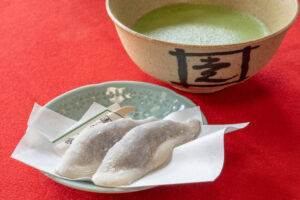
投稿タイプ:sightseeing
Hashiriimochi-rouho
Established in 1764, Hashiriimochi-rouho boasts a rich history spanning over 250 years. It’s famous for its Hashiriimochi, a soft habutaemochi (silky, tender rice cake) filled with anko (sweet red bean paste). It was offered to Emperor Meiji and Emperor Showa.
The Hashiriimochi originates from a rice cake with anko paste in it that was created in Otsu by the founder. He used spring water called "Hashirii." It is renowned water that was even used for Emperor Seimu’s first bath in his life.
Inspired by the story that Sanjo Kokaji Munechika, a swordsmith in the Heian Period (794-1185), forged his fine sword using the Hashirii, Hashiriimochi is shaped to resemble a sword.
In 1910, Hashiriimochi-rouho inherited the tradition from Otsu, and was born in front of the Ichi-no-Torii gate of the Iwashimizu Hachimangu shrine. Now it’s the only direct descendant of the originator.
Hashiriimochi is one of Yawata City’s local specialties. You can enjoy it with tea grown in Yawata at Hashiriimochi-rouho.

投稿タイプ:pamphlets
TRAVEL GUIDE KYOTO ~Discover your own Kyoto~

投稿タイプ:column
Suburban Hospitality: Immersive Homestyle Stays in Kyoto

投稿タイプ:column
Hike Through Time and Nature: Yamashiro-Kodo Road Along Train Line
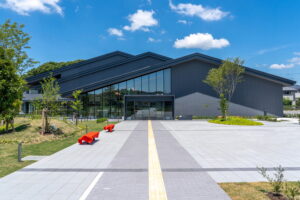
投稿タイプ:sightseeing
Historical Park of Tea and Uji Land (Chazuna)
If you want to learn about Uji tea and the history and culture of Uji, this is the perfect place to start.
With the rich history of Uji, the park is located among several historical sites, including the Uji-bashi Bridge and the Ujinowakiiratsuko Gobo tomb, housing the historic site Ujigawataikotsutsumiato (remains of the dike of Uji River that were constructed by Toyotomi Hideyoshi).
At the Communication Center of Tea and Uji Land called Chazuna, you can enjoy the museum and various experience programs related to Uji and Uji tea. Chazuna also has a museum shop, restaurant, observation terrace, and so on. The modernized Uji Meishozue (a compilation of the Edo-period pictures depicting the sights of Uji) on a large 4K HD screen is a must-see. The experience programs include matcha making from leaf-grinding, tea caddy making, tea leaf picking, and more. Through these activities, you can connect with the local people, history, and culture of Uji.
Chazuna offers various sightseeing information, too. This information and your own experiences will make your exploration of Uji even more interesting.

投稿タイプ:column
Experience the World of Tea with All Five Senses in “Kyoto Tea Country”

投稿タイプ:column
Beautiful blossoms: Kyoto’s most stunning seasonal flowers and where to admire them

投稿タイプ:column
A Day Trip to Ikkyuji Temple and Nearby Attractions: Follow Ikkyu-san’s Footsteps From Classic Anime Series

投稿タイプ:column
